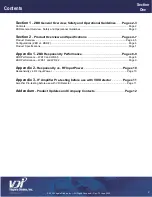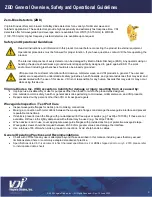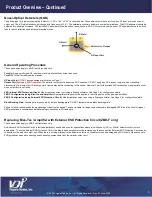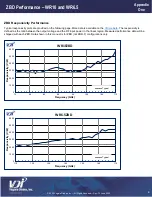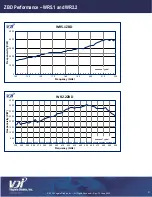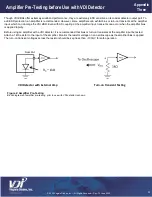
5
© 2020 Virginia Diodes, Inc.
—All Rights Reserved—Rev: 12 June 2020
Quasi-Optical Detectors (QOD)
The photograph for a typical quasi-optical detector
(~1.50” x 1.50” x 0.45”) is shown below. These detectors will have a silicon lens RF input port and a coaxial
output port. The E-Field polarization will change with frequency (±22.5°). The polarizations shown below are nominal polarizations. The QOD alignment should be
adjusted for optimal performance. VDI includes RF absorber around the silicon lens with every QOD. VDI recommends the use of RF absorber around the silicon
lens to reduce reflections and potential standing waves.
General Operating Procedure
These procedures apply to all VDI zero-bias detectors.
Turn On:
Apply small signal RF input power and monitor detector output response.
Turn Off:
Turn off small signal input power.
RF Input Port:
DO NOT exceed damage limits listed on Page 7.
Output Port (
Extremely ESD Sensitive
):
The detector output port is extremely ESD sensitive. DO NOT apply any DC biases or surges when connecting /
disconnecting from output port. Discharge static from cables before connecting to the device. Replace IF port with provided 50
Ω termination or appropriate cover
when output port is not in use.
ZBD (Internal ESD Protection Circuit):
Monitor detector output port using a floating voltmeter. See Page 6 for configuration details.
ZBD-F Configuration (using Bias-Tee and Amplifier):
Appropriate voltages must be applied to the voltage pins on the provided amplifier.
ZBD-F Configuration (using External ESD Protection Circuit):
Monitor detector output port using a floating voltmeter. See Page 6 for configuration details.
Black Backing Plate:
Unused ports are covered by a black backing plate. DO NOT tamper with the black backing plate.
Failure to follow these procedures may damage or destroy the device. The user is liable for repair costs of detectors damaged by ESD, and the use of stringent
ESD precautions is recommended when making connections to VDI detectors.
Replacing Bias-Tee / Amplifier with External ESD Protection Circuit (ZBD-F only)
These procedures apply to ZBD-F configurations only.
An External ESD Protection Circuit is included (detached) and can be used for applications where a low frequency (DC to ~50kHz) detector output is more
appropriate. To use the External ESD Protection Circuit, the bias-tee and amplifier must be removed and then connect the External ESD Protection Circuit can be
connected to the detector output port. When there is nothing attached to the detector output port, the detector can be damaged by ESD events. Please use safe
ESD guidelines when disconnecting and connecting components from the detector output port.
E-Field
Output
RF Input Port
Product Overview
–
Continued
H-Field


